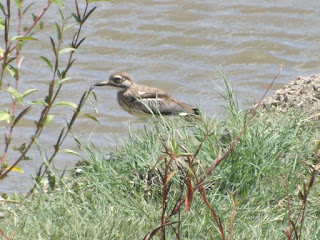At the beginning of February we attended the introductory course for the second Southern Africa Bird Atlas Project (SABAP 2) in Bulawayo Bulawayo
One of the good things about bird atlassing is that it is not only immensely valuable in itself but it also leads us into other activities. In SABAP 1 we got out to such places as Mphoengs, Gariya and Nata that we would certainly never have visited otherwise. Here at Sinamatella, with SABAP 2 we hope to use atlassing as a reason to reach some of the areas that are poorly covered by normal anti-poaching patrols and also to bring some extra meaning to ‘local’ patrols when rangers are sent into an area for a day to look for any signs of illegal activity. Usually these patrols turn up nothing but in future we hope there will be at least one positive outcome for the rangers involved – a completed bird atlas field card.
The first of these ‘atlas patrols’ took us to Matijoni – actually fairly well covered by normal patrols as it is a favourite with poachers but easily accessible as well as being somewhere we haven’t covered in birding terms. It doesn’t have a great range of habitats so our list wasn’t very exciting but I think we all learnt things from each other.
Trying to decide if it’s an African or European Golden Oriole
The best bird of the day was an Arnot’s Chat, a species that is thinly scattered in Sinamatella and for which Matijoni is a ‘new’ site as far as we are concerned.
Our second birding trip took us to Inyantue. Ariane and Michel, who are both keen birders, accompanied us. We camped at the old Inyantue gate for three nights and atlassed three pentads of which the Inyantue Dam pentad was my favourite.
We tried to follow an old abandoned game viewing road but lost it in the tall grass of a vlei…
We visited the dam itself. It was holding very little water for the time of year…..
We saw some good birds…..
Lilac-breasted Roller
And found nests…….
Nest of Cape Turtle
The next day, covering Tshompani Pan pentad, was also good. We stopped for a tea break at the Pan (which was full to the brim) and a nice old elephant came down to drink.
No doubt he was surprised to find us at this remote spot but he wasn’t alarmed.
There were very few water-birds at the pans but on an earlier trip to Shumba and Masuma we saw plenty. Dwarf Goose Pan was full of lilies and there were even some Pygmy (Dwarf) Geese there.
Male Dwarf Goose
Masuma still has a lot of water and Egyptian Geese have raised a family on the top pan.
To our surprise, Marabou Storks were apparently building nests on top of some small Mopane treess. There were four ‘nests’ in all, one of which was reasonably substantial but I don’t think this can be a genuine breeding attempt as it was within two or three meters of the ground and surely not safe – though perhaps only a brave predator would risk a peck from that big ugly beak to steal an egg or a chick.
The Marabous kept harassing a flock of Cattle Egrets, giving Sue a chance of a nice picture of egrets in flight and showing again the value of the islands that were accidentally left when the dam was scooped last year. The egrets used the islands as a refuge and there were also many other birds such as this Water Dikkop using them.
Cattle Egrets
Water Dikkop
Perhaps though, our best recent bird sighting was this Little Banded Goshawk that caught a Single-striped Mouse near the workshop at Sinamatella. The following day it took a squirrel off a tree close to our house so it probably has young to feed but we haven’t located a nest.
In all our recent trips out around the Park we have still seen very few mammals. The bush is still green and dense so it is not easy to see far from the road but most of the small water holes are now dry and the mammals will soon be arriving in numbers at the larger pans and dams where they will be more visible. The Sinamatella flood plain is already attracting elephants, buffalo, impala, kudu and giraffe which can be seen from the hill in the late afternoon. Elsewhere the game viewing is still hard work, but if you are bird atlassing there’s never a shortage of things to look at.














No comments:
Post a Comment